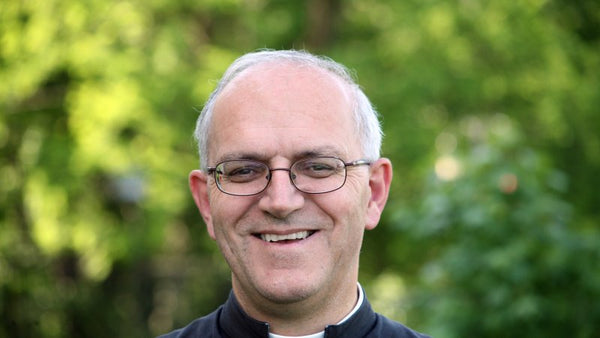The Better Part
Mary hath chosen the best part, which shall not be taken away from her. –Luke 10:42

Though it remains to be seen exactly what Pope Francis will do about cleaning the Augean stables of the curia, the task most often cited by the cardinals and media leading up to, and immediately after the election, and though we do not really know what the Holy Father will do to encourage or discourage a restoration of the liturgy on an international level, or how he will approach the much needed restoration of theology and philosophy in seminaries, we can say a few words about his style thus far, and our relationship to that style.
 When he took possession of his episcopal cathedral, St. John Lateran, yesterday, Pope Francis used the crucifix-staff designed by the Italian, Lello Scorzelli, originally given to Pope Paul VI, but becoming known most especially as the staff used by Pope John Paul II. It stands in contrast to the ferulae used by popes through the ages (previously with 3 cross-beams) and is itself novel. Beyond that, we wish to remind readers that beauty is an objective thing; we’ll leave the reader to address the question of how well the oddly bent, strangely conceived, crucifix elevates a man to the contemplation of higher things.
When he took possession of his episcopal cathedral, St. John Lateran, yesterday, Pope Francis used the crucifix-staff designed by the Italian, Lello Scorzelli, originally given to Pope Paul VI, but becoming known most especially as the staff used by Pope John Paul II. It stands in contrast to the ferulae used by popes through the ages (previously with 3 cross-beams) and is itself novel. Beyond that, we wish to remind readers that beauty is an objective thing; we’ll leave the reader to address the question of how well the oddly bent, strangely conceived, crucifix elevates a man to the contemplation of higher things.
Under Pope Benedict, though certainly not a traditionalist, we did see certain reforms and restorations. If nothing else, the restoration of a real dignity in the dress and bearing of the Sovereign Pontiff, including all of the smaller elements of style and decorum that show an understanding of the dignity of the office.
In contrast to that decorum stands Pope Francis. It’s not that we wish to nitpick, but let’s run through the Iist of these seemingly smaller changes, from not wearing the papal mozetta, not wearing the traditional red shoes, only wearing the ring of the fisherman on occasion, using decidedly more modern and less beautiful vestments, refusing to wear the papal pectoral cross – using his very modern pectoral cross instead – and now the ferula change. All of these add up to a certain “style” of the Holy Father; a style which is in contrast to his predecessors of old, and which hearkens back to the worst artistic and stylistic problems of the reigns of Pope Paul VI and Pope John Paul II. And we’re not the only ones noticing. Proponents of the so-called reform of the reform are living with a certain fear and trepidation, as it now seems that the move towards some liturgical sanity is halted, at least on the highest levels. Time alone will tell.
What interests us here is the precariousness of the situation in which so many of our fellow Catholics find themselves. Before we proceed, though, a note: It is not charitable for us to engage in attacking those fellow Catholics who are not yet traditional. To “rub it in” when they suffer, not only hurts the cause of Restoration, but is objectively sinful. Let’s maintain the high road, especially after coming through this season of Lent and the glories of the Sacred Triduum, where we remembered that our God suffered and died for us who only deserve Hell, and who did not mock or severely rebuke the Apostles who doubted, denied, and fled, but rather called them back with all the love of His Divine Heart.
 Laying that background, let us first discuss the situation of the reform of the reform. The success or lack thereof does not directly affect us, since we have not accepted the reform, and since we see the only true solution as a return to the liturgical tradition of the West, as codified in the Missal of Pope Pius V, and in all the legitimate codifications since then, until 1962.
Laying that background, let us first discuss the situation of the reform of the reform. The success or lack thereof does not directly affect us, since we have not accepted the reform, and since we see the only true solution as a return to the liturgical tradition of the West, as codified in the Missal of Pope Pius V, and in all the legitimate codifications since then, until 1962.
However, we are affected indirectly, since we seek and desire the good of the Church. Given that the majority of Catholics attend the Novus Ordo, it could only be a good thing if it was truly reformed to move more and more in line with Tradition, especially if there were an actual restoration of the Offertory rite. Again, though there is no direct affect to traditional Catholics, it is not unlikely that God will restore the liturgy of His Church by moving the Novus Ordo rites further towards our liturgical tradition.
The purpose of today’s point, however, is to show the stability of Tradition and traditional Catholics.
There are at least two reasons why traditional Catholics need not worry about the constant changing and inherent instability that so greatly affects the Novus Ordo.
The first reason is that the ancient liturgy corresponds to the constant and ancient doctrine of the Church. It receives its vitality from that doctrine, and it also builds up and protects the doctrines with which it corresponds. In this way, though admitting of changes and reform (a la Pope St. Pius V), it has an inherent stability. The doctrine of the Church is timeless and unchanging; so a liturgy that corresponds with the timelessness and immutability of doctrine possesses a constancy unknown in the Novus Ordo, a rite attached very much to the theological fads and opinions of the 1960s.
The second reason the ancient liturgy possesses greater stability is the understanding of liturgy as something fixed (or at least not admitting of inorganic change). The idea that popes, bishops, or priests would bring their own liturgical “style” to bear upon the liturgy is simply unthinkable for the liturgical tradition of the West – and the East for that matter. Instead, the liturgy is something fixed (though not something dead) which binds the priest (or bishop or pope) and to which the priest is faithful.
To say that this same understanding of liturgy as something outside preference or style exists in the Novus Ordo is absurd on its very face. From the almost countless options available to the celebrant, to the almost constant changes and legislation made concerning the liturgy (to make sure it’s up-to-date enough), to the very fact that liturgical laws drastically differ from country to country, and from diocese to diocese, we can only say that the Novus Ordo lacks this understanding of a fixed liturgy to which the priest is faithful, and which in turn will form the priest and the community in the mind of the Church.
 And so, in the midst of papal controversy, changing styles, a veritable war made for the life of the liturgy through much of the Church, let us first invite all Catholics to come with us to the altar of God; to God who giveth joy to my youth, and to worship God in what Fr. Faber called, “the most beautiful thing this side of Heaven.” There they will find the peace and stability that belongs to Catholics as part of their patrimony.
And so, in the midst of papal controversy, changing styles, a veritable war made for the life of the liturgy through much of the Church, let us first invite all Catholics to come with us to the altar of God; to God who giveth joy to my youth, and to worship God in what Fr. Faber called, “the most beautiful thing this side of Heaven.” There they will find the peace and stability that belongs to Catholics as part of their patrimony.
And to those of us who are already traditional, let us never forget the great glory of the Ancient Mass, and let us rest confidently that through no merit of ours, but out of the great mercy of Christ, we have chosen the better part, and it shall not be taken from us.
Leave a comment
Comments will be approved before showing up.
Also in Angelus Press Blog

Angelus Press Website Update is Complete

Angelus Press Website Updates for Wholesale Accounts

Fr. Dominique Bourmaud Passes Away
With great sadness, the U.S. District of the Society of Saint Pius X (SSPX) announces the passing of Fr. Dominique Bourmaud. He went to his eternal reward in the early hours of Saturday, September 4, 2021.
Eternal rest grant unto Fr. Dominique Bourmaud, O Lord, and let perpetual light shine upon him. May he rest in peace. Amen.

Brent Klaske
Author
Director of Operations at Angelus Press. I have worked in Catholic publishing for more than 20 years. I currently live near St. Marys, KS with my wife and 10 children.